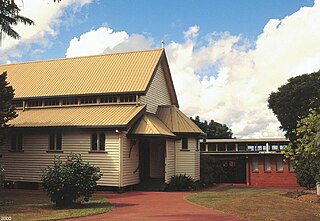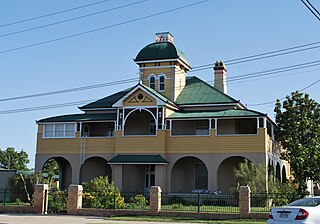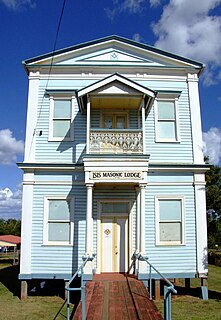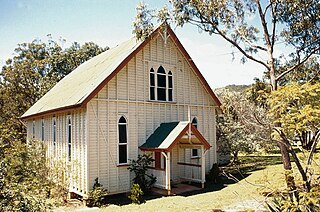
Wonglepong is a rural locality in the Scenic Rim Region of Queensland, Australia.

Christ Church is a heritage-listed church at 24 Macrossan Street, Childers, Bundaberg Region, Queensland, Australia. It was designed by John Hingeston Buckeridge and built from 1900 to 1958. It is also known as the Anglican Church. It was added to the Queensland Heritage Register on 28 April 2000.

St Agnes Anglican Church is a heritage-listed churchyard at Ipswich Street, Esk, Somerset Region, Queensland, Australia. It was designed by John Hingeston Buckeridge and built in 1889 by Lars Andersen. It is also known as St Agnes Rectory and Church Hall. It was added to the Queensland Heritage Register on 21 October 1992.

Monkton is a heritage-listed timber-framed domestic house at 7 Ardoyne Road, Corinda, City of Brisbane, Queensland, Australia. It was designed by Elina Mottram and built in 1925 for William and Margaret Dunlop. It is designed by Elina Emily Mottram, who was the first woman in Queensland to establish her own architectural practice. It is historically significant because of its association with the entry of women into the local professions in Queensland, especially so into the architectural profession. It was added to the Queensland Heritage Register on 31 July 2008.

All Saints Memorial Church is a heritage-listed Anglican church at Tamrookum Church Road, Tamrookum, Scenic Rim Region, Queensland, Australia. It was designed by Robin Dods and built in 1915. It was added to the Queensland Heritage Register on 21 October 1992.

St Patrick's Church is a heritage-listed Roman Catholic church at Rosewood - Aratula Road, Rosevale, Scenic Rim Region, Queensland, Australia. It was designed by Father Andrew Horan and built from 1888 to 1889. It was added to the Queensland Heritage Register on 11 December 2009.

Numinbah Valley School of Arts is a heritage-listed school of arts at Nerang - Murwillumbah Road, Numinbah Valley, City of Gold Coast, Queensland, Australia. It was added to the Queensland Heritage Register on 7 December 2007.

Uanda is a heritage-listed detached house at 27 Clifton Street, Wilston, City of Brisbane, Queensland, Australia. It was designed by Nellie McCredie and built in 1928. It was added to the Queensland Heritage Register on 24 March 2000.

St John's Church is a heritage-listed Anglican church at Mundoolun Road, Mundoolun, City of Logan, Queensland, Australia. It was designed by John Hingeston Buckeridge and built from 1901 to 1915. It is also known as Memorial Church of St John the Evangelist. It was added to the Queensland Heritage Register on 26 November 1999.

Purga United Church is a heritage-listed church at Boonah Road, Purga, City of Ipswich, Queensland, Australia. It was built in 1922. It was added to the Queensland Heritage Register on 6 September 2005.

St Brigids Catholic Church is a heritage-listed Roman Catholic church at 28 Matthew Street, Rosewood, City of Ipswich, Queensland, Australia. It was designed by Reverend Andrew Horan and built in 1909 by RJ Murphy with alterations in 1935. It was added to the Queensland Heritage Register on 21 October 1992.

St Augustines Anglican Church is a heritage-listed church at Dove Street, Leyburn, Southern Downs Region, Queensland, Australia. It was designed by Richard George Suter and built from 1871 to 1918. It is also known as St Augustine's Church of England. It was added to the Queensland Heritage Register on 21 August 1992.

St Mary's Presbytery is a heritage-listed Roman Catholic presbytery of St Mary's Roman Catholic Church at 142 Palmerin Street, Warwick, Southern Downs Region, Queensland, Australia. It was designed by Wallace & Gibson and built from 1885 to 1887 by John McCulloch. It is also known as Father JJ Horan's private residence. It was added to the Queensland Heritage Register on 31 July 2008.

Isis Masonic Lodge is a heritage-listed masonic temple at 18 Macrossan Street, Childers, Bundaberg Region, Queensland, Australia. It was designed by F H Faircloth and built from 1897 to 1909. It is also known as Corinthian Lodge. It was added to the Queensland Heritage Register on 28 April 2000.

Shepherd Memorial Church of St Peter is a heritage-listed Anglican church at the corner of Drake Street and Wondai Road, Proston, South Burnett Region, Queensland, Australia. It was designed by Fowell, McConnel and Mansfield and built from 1937 to 1939 by Lesleigh George Windmell Smith. It was added to the Queensland Heritage Register on 9 November 2012.

Herberton Uniting Church is a heritage-listed church at 2-4 Lillian Street, Herberton, Tablelands Region, Queensland, Australia. It was built in 1891 by R Petersens. It is also known as Herberton Presbyterian Church. It was added to the Queensland Heritage Register on 27 August 1999.

Cactoblastis Memorial Hall is a heritage-listed memorial at Warrego Highway, Boonarga, Western Downs Region, Queensland, Australia. It was built in 1936 by Jack Schloss. It was added to the Queensland Heritage Register on 21 September 1993.

Stanthorpe Post Office is a heritage-listed post office at 14 Maryland Street, Stanthorpe, Southern Downs Region, Queensland, Australia. It was designed by John Smith Murdoch of the Queensland Government Architect's office and was built by D. Stewart and Co in 1901. It was added to the Australian Commonwealth Heritage List on 22 June 2004.

Cooroy Post Office is a heritage-listed post office at 33 Maple Street, Cooroy, Shire of Noosa, Queensland, Australia. It was designed by Thomas Pye and built in 1914 by L. Baldry. It was added to the Australian Commonwealth Heritage List on 22 August 2012.

Ingham Post Office is a heritage-listed post office at 15 Lannercost Street, Ingham, Shire of Hinchinbrook, Queensland, Australia. It was built in 1935. It was added to the Australian Commonwealth Heritage List on 22 August 2012.






















